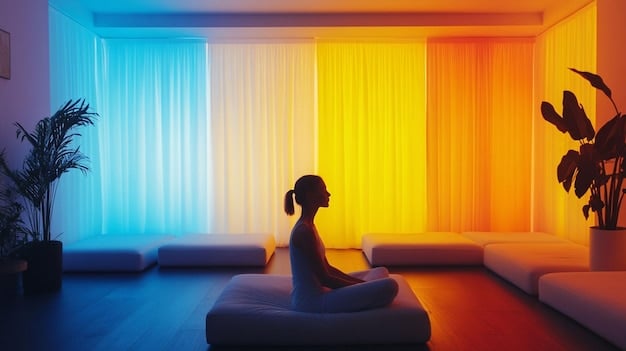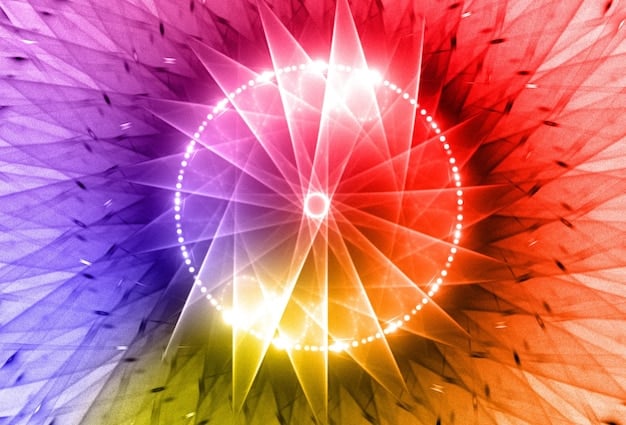Color Meditation: Balance Emotions & Enhance Your Practice

Color meditation is a technique that uses the power of color to deepen your meditation practice, promoting emotional balance and enhancing overall well-being by focusing on specific colors and their associated energies.
Dive into the vibrant world of **color meditation**, a powerful technique to enhance your meditation practice and promote emotional balance. By focusing on specific colors, you can harness their energy to deepen your meditation experience and improve your overall well-being.
What is color meditation?
Color meditation, also known as color breathing or color visualization, is a specific type of meditation therapy that harnesses the power of color to promote healing and balance the mind, body, and spirit. It’s a form of mindfulness that combines focused attention techniques with the unique energy of specific colors to evoke desired emotional and mental states.
Unlike other forms of meditation that might focus on breath or mantra, color meditation uses mental imagery to visualize colors and their corresponding properties.
The history of color meditation
The concept of color and its influence on well-being has been around for centuries. Ancient civilizations such as the Egyptians and Chinese had their own color theories. However, color meditation as we know it today has evolved from these traditional ideas and contemporary research. Carl Jung’s work on symbolism and color psychology helped to shape the field and continues to evolve.
How color meditation works
Based on the idea that each color has a unique vibrational frequency and a set of emotional and psychological associations, color meditation involves focusing your mind on a particular color and visualizing it surrounding you, filling every cell of your body. The color’s vibration is believed to influence your energy field, harmonizing and balancing your emotions.

- Red: Stimulates energy; associated with courage and vitality.
- Orange: Promotes joy and creativity; connected to optimism and enthusiasm.
- Yellow: Enhances focus and mental clarity; linked to confidence and personal power.
- Green: Fosters healing and balance; resonates with love and compassion.
Color meditation can be performed in various ways, depending on individual needs and preferences. Some people find it helpful to use colored objects or lights to enhance their visualization, while others prefer to simply close their eyes and call upon the images in their mind.
In conclusion, color meditation is a practice where you use the power of colors to influence your emotional and spiritual state. By focusing on the energy of a particular color, you can bring about healing and balance to your mind, body, and spirit, adding a unique and colorful dimension to your meditation routine.
Benefits of Color Meditation
Color meditation is more than just a visual experience. It offers a range of benefits that enhance your mental, emotional, and physical well-being. By integrating color into your meditation practice, you can unlock new dimensions of relaxation, balance, and healing.
Here are some of the key benefits of incorporating color into your meditation practice:
Emotional balance
The inherent property of each color is associated with specific emotions, which can help balance out feelings. Blue is often used to calm anxiety, and yellow to boost confidence. The practice of color meditation helps you connect to the specific frequency of the desired color, allowing healing and a more harmonized emotional state.
Stress Reduction
By focusing on colors and their calming energies, you can activate the relaxation response in your body, which helps to lower cortisol levels and reduce feelings of stress and anxiety.
Enhanced creativity
Certain colors, such as orange and yellow, stimulate creativity and can help unlock new ideas and perspectives. Visualizing these colors during meditation can open up creative channels and inspire innovative thought. Regular practice of this meditation technique helps create a clear channel to promote creative insight.

- Improved sleep quality: Meditating with calming colors such as indigo can promote relaxation and improve sleep patterns.
- Increased self-awareness: Tuning into your emotional response to various colors can offer insights into your subconscious and increase self-understanding.
- Pain management: Visualizing colors like blue and violet can help soothe pain and discomfort by calming the nervous system.
Overall, integrating color meditation into your life is a holistic way to nurture your physical, mental, and emotional well-being. It’s a powerful tool that can bring balance and enrich your daily life.
To sum up, color meditation offers a wide array of benefits, from emotional balance and stress reduction to enhanced creativity and improved sleep. By incorporating this practice into your routine, you can experience a more balanced and enriched life.
How to Prepare for Color Meditation
Preparing for color meditation involves setting the stage and knowing how to approach your practice. Here are some key steps to ensure you get the most out of your color meditation session:
By focusing on these details, you can ensure that your meditation session is effective and enjoyable.
Choose the right environment
Select a quiet space where you can meditate without interruptions. Ensure the environment is clean and comfortable, free from loud noises and distractions. Consider the lighting; soft, natural light can enhance the experience, especially if you’re using colored lights or objects in your meditation.
Settle into a comfortable position
Choose a comfortable seated position and make sure your spine is straight. Whether you prefer sitting on a cushion, chair, or the floor, maintain proper posture to support your energy flow.
Set your intention
Before you begin, take a moment to set your intention for the meditation. What do you hope to achieve with this session? Are you seeking emotional healing, increased creativity, or relaxation? Having a clear intention will guide your practice. Define your goals before you meditate to create a strong foundation for the session.
When it comes to color selection in meditation, there are a few things to keep in mind:
- Select your color: Choose a color that resonates with your intention. Refer to the color’s associations to guide your choice. For example, if you seek relaxation, blue might be a good option, while yellow is appropriate for boosting energy.
- Use color aids: You can enhance your meditation with visual aids such as colored candles, fabrics, or images. These aids can help you focus your mind and deepen your meditation experience.
- Prepare your body: Hydrate before you start to stay alert and comfortable during your meditation session.
With good physical and mental preparation, you set a strong foundation for an effective and transformative color meditation session.
In short, good preparation is key to a successful color meditation session. From setting the environment and comfortable position to defining your intention and choosing the right color, these steps greatly enhance your meditation experience.
Guided Color Meditation Techniques
A guided color meditation is a great way to enhance your practice and achieve a deeper sense of calm and well-being. Whether you’re a beginner or an experienced meditator, these techniques will help you harness the power of color.
Whether you’re visualizing colors, breathing in their energy, or using colored aids, these techniques provide structured methods to fully engage with the healing power of color.
Visualization technique
The first step is to close your eyes and take a few deep breaths to relax your body and mind. Then, focus your mind on the chosen color. Imagine the chosen color enveloping you, filling your body, and surrounding you in a warm, protective light. Take slow, deep breaths as you visualize and immerse yourself in the color’s energy, repeating affirmations that align with the color’s essence. This approach helps you to fully connect with the color’s energy.
Breathing the color
Begin by visualizing the color in front of you. Take a deep breath and imagine inhaling the very essence of the color right through your nostrils. As you exhale, feel the color spreading throughout your body, gently releasing tension and replacing any negative energy with the color’s therapeutic essence. Let the breath infuse every part of your being.
Using colored aids
Colored candles, fabrics, or images can deepen your meditative state. Place a colored object in front of you and focus on its hue, shape, and texture. Allow its essence to permeate your senses. Observe how the color affects your emotions and thoughts, and let it guide you toward deeper concentration.
- Affirmation exercise: Speak positive affirmations related to the color. For example, with blue, affirm ‘I am calm and at peace.’
- Body scan: Visualize the chosen color moving through each part of your body, starting from the toes to the crown of your head. Identify areas where you feel tension and allow the color’s healing energy to dissolve it.
- Mindful observation: Pay attention to any thoughts or emotions that arise during the meditation. Acknowledge them without judgment, and gently guide your focus back to the color.
Through these exercises, you can enhance your meditation and unlock the transformative power of color, leading to a more balance and centered state of being.
In summary, guided color meditation techniques provide a structured way to connect with the healing power of color. Through visualization, breathing, and using colored aids, you can deepen your meditation practice and promote overall well-being and balance.
Color Associations and Their Meanings
Understanding the associations of colors can greatly enhance your meditation practice. Each color corresponds to unique emotional, psychological, and spiritual qualities. By knowing these properties, you can strategically choose colors that align with your intentions and needs.
Therefore, knowledge of what each hue means is an essential tool in your meditation arsenal.
Red – Energy and vitality
This color symbolizes energy, vitality, courage, and passion. It’s an excellent choice when you need a boost of physical energy or to overcome feelings of lethargy. Also, red encourages action and assertiveness.
Blue – Calm and peace
Blue is associated with tranquility, peace, and relaxation. This hue is perfect for meditation if you’re feeling stressed, anxious, or overwhelmed. Using this color can calm your mind and lower your heart rate, making you feel more centered.
Green – Healing and balance
Associated with healing, growth, and balance, green helps promote harmony and renewal on all levels: physical, emotional, and spiritual. If you’re seeking emotional balance, visualizing green can bring a sense of calm and equilibrium.
Likewise, some other colors will impact the qualities of your meditation session:
- Yellow: Enhances mental clarity and focus; symbolizes optimism and confidence.
- Orange: Stimulates creativity and joy; fosters enthusiasm and social connection.
- Purple: Connects to spirituality and intuition; enhances insight and transformation.
Knowing these color associations enables you to personalize your meditation practice and better target your desired results. Whether you need energy, calmness, or healing, choose a color that resonates with your intention to enhance the power of your meditation.
In short, a good knowledge of color associations is essential for targeted meditation. Whether needing vitality, peace, or healing, selecting the appropriate color enhances the focus of your meditation practice.
Integrating Color Meditation into Your Daily Life
Integrating color meditation into your daily life doesn’t have to be a difficult task. With a few simple strategies, you can create space for this practice and enjoy its benefits regularly. Making a small change to your routine can promote emotional balance and overall well-being. Here’s some ways to begin.
Whether through short morning practices, moments of mindful breathing, or using colored objects, you can incorporate color meditation seamlessly into your daily life.
Start with short morning sessions
By starting your day with even just 5-10 minutes of this practice will set a positive tone for the rest of your day. Choose a color that resonates with your intentions for the day and visualize it as you wake up. For example, visualize yellow to bring focus and optimism to your day and help energize your mind.
Use mindful breathing breaks
Incorporate a brief color-focused breathing practice during breaks at work or home. Close your eyes, visualize a calming color like blue or green, and take slow, deep breaths for a few minutes. This can greatly reduce stress and re-energize you throughout the day.
Create a color-themed space
Surround yourself with colors that support your intentions. Add splashes of calming blue to your bedroom or energizing orange to your workspace. The consistent visual stimulation will subtly reinforce the color’s positive effects and enhance your emotional state.
Moreover, here are a few ways you can easily turn the practice to a part of your daily ritual:
- Incorporate into other rituals: Take advantage of daily routines like showering or exercising by consciously visualizing a beneficial color during these activities.
- Use colored accessories: Wear clothing or jewelry in the colors that match your intention for the day. This will act as a constant visual reminder of its impact.
- Before sleep: Prior to going to bed, meditate with calming indigo to prepare for a restful night.
Integrating color meditation into your life offers consistent benefits, promoting emotional balance, focus, and well-being. The daily routine helps the process evolve and grow in terms of results.
Ultimately, integrating color meditation into your daily life is all about creating simple and consistent habits that infuse your day with color. By incorporating these small practices, you can enjoy increased emotional balance and overall wellness.
| Key Point | Brief Description |
|---|---|
| 🌈 Color Meditation | Uses colors to balance mind, body, and spirit. |
| 🧘 Benefits | Reduces stress, enhances creativity, and balances emotions. |
| 🎨 Color Meanings | Each color has unique properties, like blue for calm and red for energy. |
| ✨ Daily Practice | Incorporate colors into your daily routine for consistent benefits. |
Frequently Asked Questions
▼
The basic principle behind color meditation is that each color has a unique energy and corresponding emotion. Concentrating on these colors promotes balance in your emotional and spiritual life.
▼
A color meditation session can last anywhere from 5 to 30 minutes, depending on your needs and schedule. Short, consistent sessions can be as effective as longer, occasional ones.
▼
While possible, it’s generally recommended to focus on one color per session, especially when you’re starting out. This allows you to fully immerse yourself in the color’s energy and benefits.
▼
Generally, there are no colors to avoid. However, if a particular color evokes negative emotions for you, it’s best to choose a different one that resonates more positively with your intentions.
▼
Tools such as colored candles, fabrics, or nature settings can enrich color meditation. Also, incorporating aromatherapy with scents that complement the chosen color can enhance your practice.
Conclusion
In summary, **color meditation** is a powerful tool for enhancing your meditation practice and promoting emotional balance. By understanding the meanings of different colors and integrating them into your daily routine, you can unlock a new level of calm, creativity, and overall well-being.





